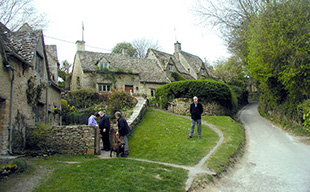












The area has been designated as the CotswoldArea of Outstanding Natural Beauty. The highest point in the Cotswolds range is Cleeve Hill at 1,083 feet (330 m), 2.5 miles (4 km) to the north of Cheltenham.
Location
The Cotswolds lie mainly within the ceremonial counties of Gloucestershire, Oxfordshire and Warwickshire, but extend into parts of Wiltshire, Somerset and Worcestershire.
Description
The spine of the Cotswolds runs south west to north east through six counties, particularly Gloucestershire, west Oxfordshire, and south western Warwickshire. The northern and western edges of the Cotswolds are marked by steep escarpments down to the Severn valley and the Warwickshire Avon. This escarpment or scarp feature, sometimes called the Cotswold Edge, is a result of the uplifting (tilting) of the limestone layer, exposing its broken edge. This is a cuesta, in geological terms. The dip slope is to the south east. On the eastern boundary lies the city of Oxford and on the west is Stroud. To the south the middle reaches the Thames Valley and towns such as Cirencester, Lechlade, Tetbury and Fairford are often considered to mark the southern limit of this region. However, key features of the area, especially the characteristic uplift of the Cotswold Edge, can be clearly seen as far south as Bath and towns such as Chipping Sodbury and Marshfield share elements of Cotswold character.
The area is characterised by attractive small towns and villages built of the underlying Cotswold stone (a yellow oolitic limestone). This limestone is rich in fossils, in particular fossilised sea urchins. In the Middle Ages, the wool trade made the Cotswolds prosperous; hence the Speaker of the British House of Lords sits on the Woolsack showing where the Medieval wealth of the country came from. Some of this money was put into the building of churches so the area has a number of large, handsome Cotswold stone "wool churches". The area remains affluent and has attracted wealthy people who own second homes in the area or have chosen to retire to the Cotswolds.
Typical Cotswold towns are Bourton-on-the-Water, Broadway, Burford, Chipping Norton, Cirencester, Moreton-in-Marsh, Stow-on-the-Wold and Winchcombe. The town of Chipping Campden is notable for being the home of the Arts and Crafts movement, founded by William Morris at the end of the 19th and beginning of the 20th centuries. William Morris lived occasionally in Broadway Tower a folly now part of a country park. Chipping Campden is also known for the annual Cotswold Games, a celebration of sports and games dating back to the early 17th century.
By Appointment
PARIS CERAMICS
South Park Studios - Suite 10
88 Peterborough Road, London SW6 3HH
United Kingdom